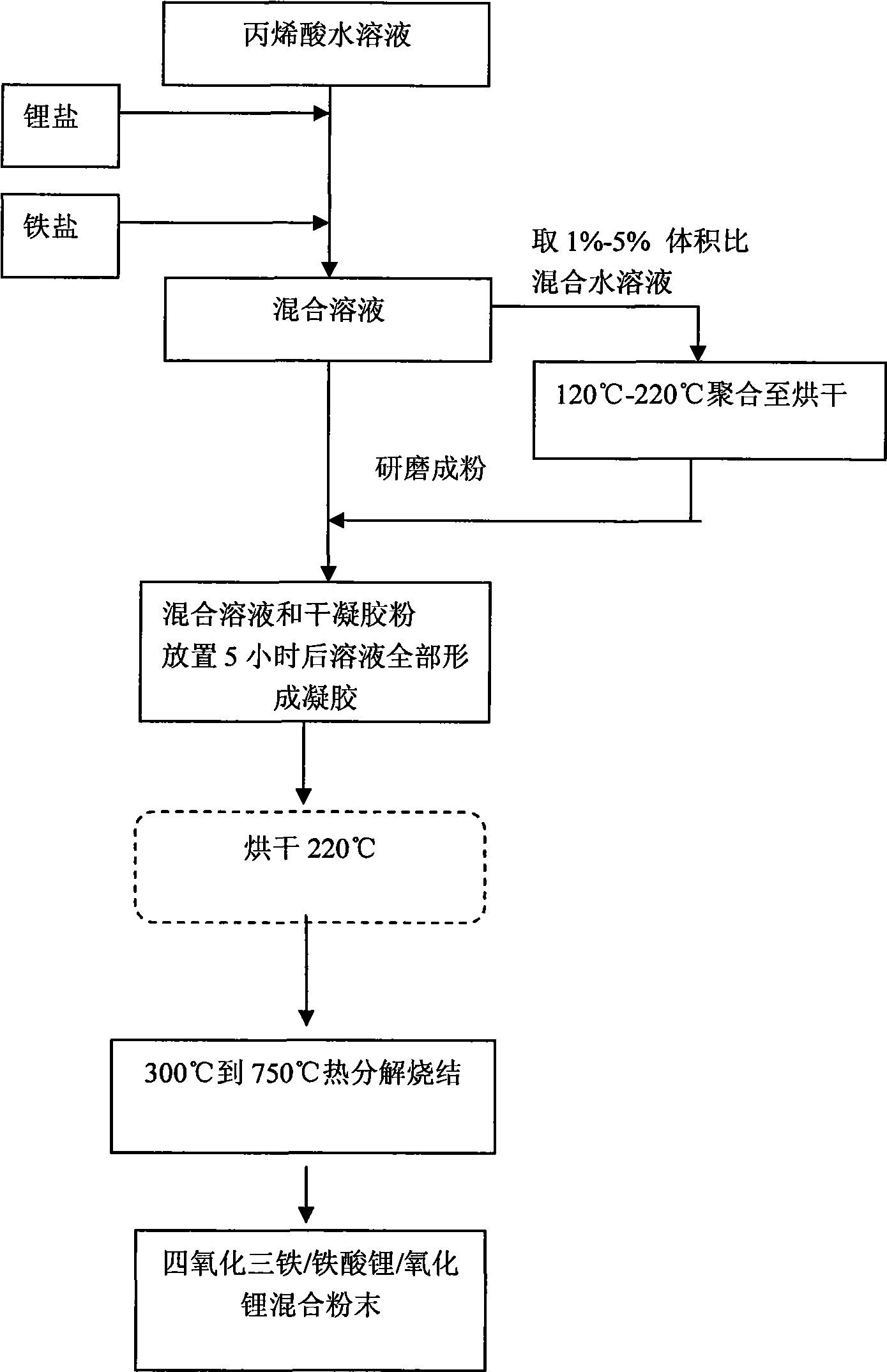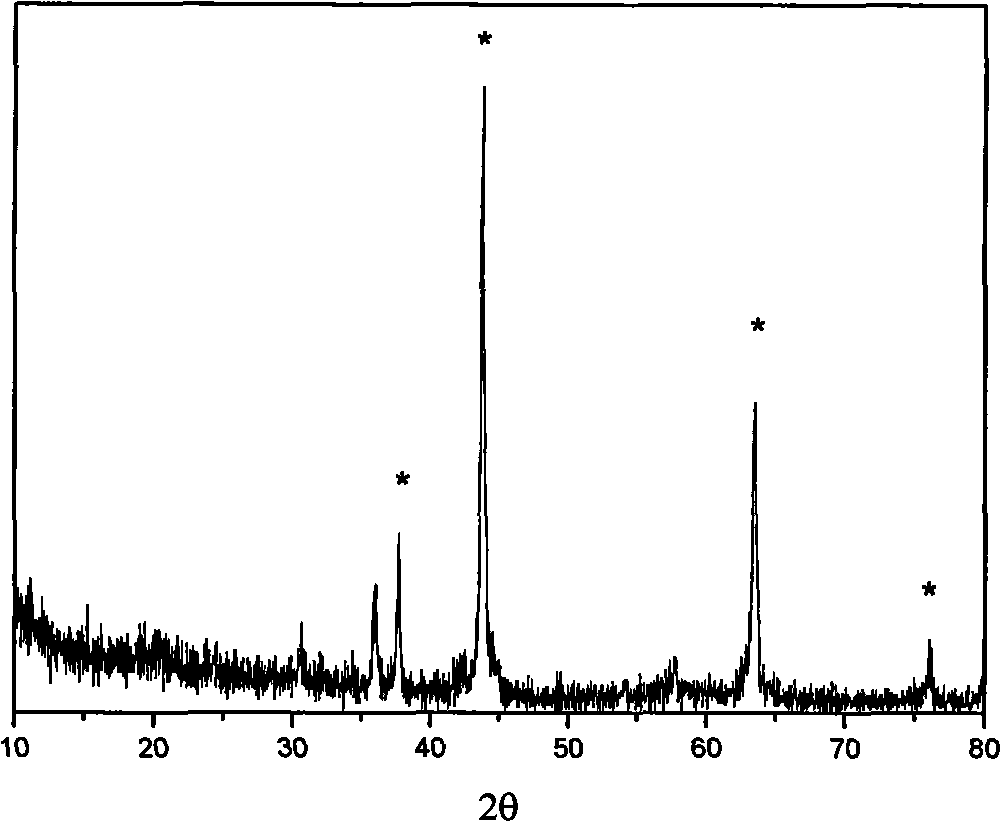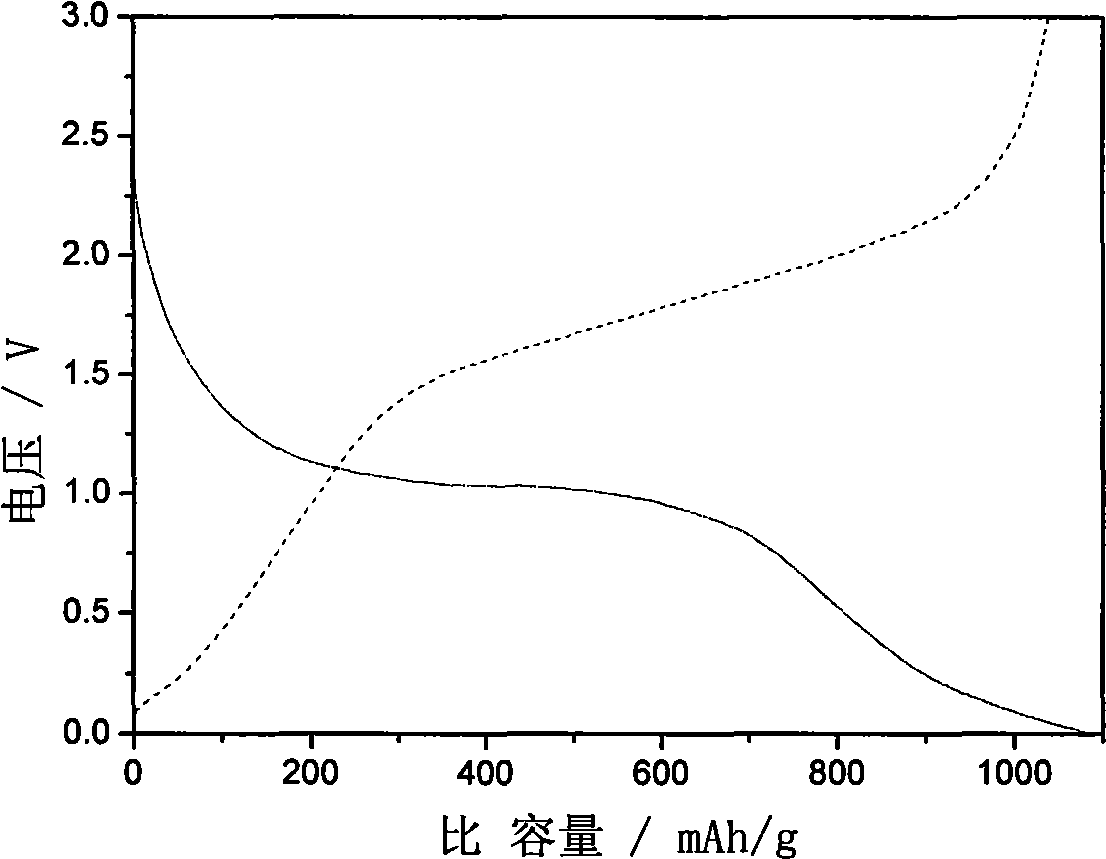Lithium ion battery cathode material and preparation method
A technology for lithium-ion batteries and negative electrode materials, applied in electrode manufacturing, battery electrodes, circuits, etc., to achieve the effects of reduced consumption, wide range of raw materials, and easy mass production
- Summary
- Abstract
- Description
- Claims
- Application Information
AI Technical Summary
Problems solved by technology
Method used
Image
Examples
Embodiment 1
[0032] see figure 1 , respectively take 2.068g of lithium nitrate LiNO 3 and 12.12g of iron nitrate nonahydrate Fe(NO 3 ) 3 9H 2 O (that is, the molar ratio of Li:Fe is 1:1), fully dissolved in 75ml of water by stirring, then add 25ml of acrylic acid, after mixing evenly, a mixed aqueous solution is obtained, take 5ml of the mixed aqueous solution and heat and polymerize at 180°C until drying (approximately 4 hours), to obtain black xerogel, then grind to obtain xerogel powder, this xerogel powder is added in remaining 95ml mixed aqueous solution, after standing at room temperature for 5 hours, mixed aqueous solution forms gel, see figure 2 , then heated to 450°C to decompose the organic matter in the gel, and sintered for 10 hours to obtain ferric oxide / lithium ferrite / lithium oxide Fe 3 o 4 -LiFeO 2 -Li 2 O composite powder.
[0033] With the ferric oxide / lithium ferrite / lithium oxide Fe that embodiment 1 makes 3 o 4 -LiFeO 2 -Li 2 O composite powder is used as ...
Embodiment 2
[0036] Take 1.034g of lithium nitrate LiNO respectively 3 and 3.03g of iron nitrate nonahydrate Fe(NO 3 ) 3 9H 2 O (i.e. the molar ratio of Li:Fe is 2:1), stirred and dissolved in 75ml of water, then added 25ml of acrylic acid, after mixing evenly, a mixed aqueous solution was obtained, and 5ml of the mixed aqueous solution was heated and polymerized at 120°C until dried. Obtain black dry gel, then grind to obtain dry gel powder, add this dry gel powder to the remaining 95ml mixed aqueous solution, after 5 hours, mix the aqueous solution to form a gel, then heat to 750°C to decompose the organic matter in the gel, Sintering for 10 hours to obtain ferric oxide / lithium ferrite / lithium oxide Fe 3 o 4 -LiFeO 2 -Li 2 O composite powder, using the powder as negative electrode, the measured discharge specific capacity is greater than 1000mAh / g.
Embodiment 3
[0038] Take 0.207g of lithium nitrate LiNO respectively 3 and 12.12g of iron nitrate nonahydrate Fe(NO 3 ) 3 9H 2 O (i.e. the molar ratio of Li:Fe is 1:10), stirred and dissolved in 75ml of water, then added 25ml of acrylic acid, after mixing evenly, a mixed aqueous solution was obtained, and 5ml of the mixed aqueous solution was heated and polymerized at 220°C until drying to obtain Black dry gel, then grind to obtain dry gel powder, add the dry gel powder to the remaining 95ml mixed aqueous solution, after 5 hours, mix the aqueous solution to form a gel, then heat to 300°C to decompose the organic matter in the gel, and sinter 10 hours, obtain ferric oxide / lithium ferrite / lithium oxide Fe 3 o 4 -LiFeO 2 -Li 2 O composite powder, using the powder as negative electrode, the measured discharge specific capacity is greater than 1000mAh / g.
[0039] With the Fe that embodiment 3 makes 3 o 4 -LiFeO 2 -Li 2 O composite powder and graphite are mixed at 3:1 and 1:10 to make...
PUM
| Property | Measurement | Unit |
|---|---|---|
| Discharge capacity | aaaaa | aaaaa |
| Discharge specific capacity | aaaaa | aaaaa |
| Discharge specific capacity | aaaaa | aaaaa |
Abstract
Description
Claims
Application Information
 Login to View More
Login to View More - R&D Engineer
- R&D Manager
- IP Professional
- Industry Leading Data Capabilities
- Powerful AI technology
- Patent DNA Extraction
Browse by: Latest US Patents, China's latest patents, Technical Efficacy Thesaurus, Application Domain, Technology Topic, Popular Technical Reports.
© 2024 PatSnap. All rights reserved.Legal|Privacy policy|Modern Slavery Act Transparency Statement|Sitemap|About US| Contact US: help@patsnap.com










